There are 13 native types of turtles in Iowa, ranging from iconic species like the Common Snapping Turtle to beautiful specimens like the Ornate Box turtles, and to endangered species like the Blanding turtle.
Iowa provides several habitats that are ripe for turtles. The Mississippi and Missouri rivers provide the main sources of aquatic habitat, while some species prefer to keep to woodland or marshes. Here’s our guide to the turtle species native to Iowa.
Table of Contents
- Wood Turtle
- Red Eared Slider
- Common Snapping Turtle
- Painted Turtle
- Blandings Turtle
- Common Musk Turtle
- Yellow Mud Turtle
- Smooth Softshell Turtle
- Spiny Softshell Turtle
- Northern Map Turtle
- Ouachita Map Turtle
- False Map Turtle
- Ornate Box Turtle
Turtles In Iowa
1. Wood Turtle
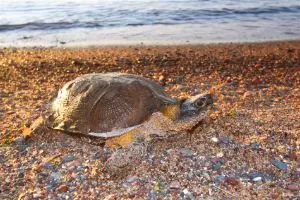
Experience Level: Intermediate
Family: Emydidae
Scientific Name: Glyptemys Insculpta
Adult Size: Between 5 ½ to 8 inches
Lifespan: 40 years in the wild, 58 years in captivity
Average price range: Between $249 and $495
Recommended books: Wood Turtles: A Pet Care Guide for Wood Turtles by Lolly Brown
Wood turtles are an intelligent species mainly found in the Cedar River region in the northeast of Iowa. Their main habitats are woodlands and ponds.
They are active during the day and roam widely while looking for food. They are omnivores and often eat berries, plants, mollusks, and earthworms. They can rock themselves to create vibrations in the soil, fooling worms into thinking it’s raining.
Wood turtles are so named for their shells, which are rough and feel like wood. Their patterning looks similar to growth rings and wood grain. They are mostly brown in color.
2. Red Eared Slider
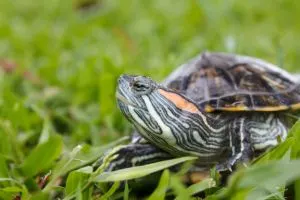
Experience Level: Beginner
Family: Emydidae
Scientific Name: Trachemys Scripta Elegans
Adult Size: Between 6 and 8 inches
Lifespan: Between 20 and 40 years
Everyone is likely familiar with the Red Eared Slider, one of the most common types of pet turtle on the market. This semi-aquatic species is considered invasive in many areas.
They usually dwell in Iowa’s southeastern rivers. These turtles like to bask at the water’s edge, and often stack themselves on top of each other!
Red Eared Sliders commonly have an olive green shell bearing yellow-striped markings on their scales. Their heads are usually a darker color, with yellow stripe markings and red patches just behind their eyes.
Their omnivorous diet consists of small fish, aquatic invertebrates, and underwater vegetation.
3. Common Snapping Turtle
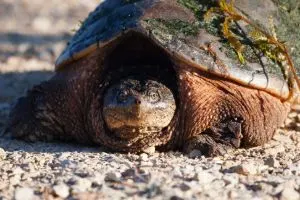
Experience Level: Intermediate to Expert
Family: Chelydridae
Scientific Name: Chelydra Serpentina
Adult Size: Between 8 and 20 inches
Lifespan: Between 30 and 50 years
Average price range: Between $20 and $40
Recommended books: Snapping Turtle Pet Owners Guide by Ben Team
The largest turtles native to Iowa, Common Snappers can be found across the state in many bodies of water. They can be aggressive and will often hiss and bite. They do not bask often, preferring to remain in the water.
Identified by their distinctive hooked “beaks”, Common Snappers usually have dark brown or green shells. They also have relatively strong claws and long tails that sport saw-toothed ridges.
Common Snappers are nocturnal omnivores, mainly eating fish and other aquatic prey. They also consume underwater vegetation. There have been some instances of Snappers eating small waterbirds if they get close enough.
4. Painted Turtle
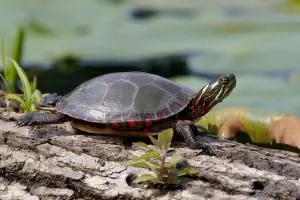
Experience Level: Beginner
Family: Emydidae
Scientific Name: Chrysemys Picta
Adult Size: Between 4 and 10 inches
Lifespan: Between 30 and 50 years
Average price range: Between $20 and $50
Recommended books: Painted Turtle Pet Owners Guide (Ben Team)
Another common pet species, Painted turtles have dark shells with faint yellow stripe markings. Their plastrons are orange to red, with black and yellow patterning. They are found across the entire state of Iowa.
Mainly an aquatic species, Painted turtles stay near the water and like to bask, and can be seen doing so from early spring. During mating, males will vibrate their claws against the female to entice her to mate.
Although omnivorous, Painted turtles must swallow their food in the water because their tongues are fixed. They mainly eat mollusks, frogs, and underwater invertebrates.
5. Blanding’s Turtle
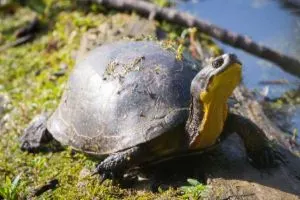
Experience Level: Intermediate
Family: Emydidae
Scientific Name: Emydoidea blandingii
Adult Size: Between 5 and 8 inches
Lifespan: Up to 80 years
Average price range: Between $300 and $450
Named after naturalist William Blanding, these characterful turtles are also known as “the turtle that smiles”. Blanding’s turtles have dark oval shells with yellow speckling. Their plastrons are yellow with black patches
A threatened species in Iowa, Blanding’s turtles can be found across the state. Populations have been dispersed by threats to their preferred marshy habitats. They are cautious, often diving to safety or retracting into their shells at any sign of trouble.
Blanding’s turtles are omnivorous, mainly eating crayfish, earthworms, and water-borne insects. They also occasionally eat plants and do not rely on water to help them swallow.
6. Common Musk Turtle
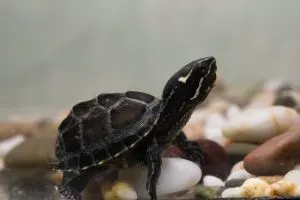
Experience Level: Intermediate
Family: Kinosternidae
Scientific Name: Sternotherus Odoratus
Adult Size: Between 4 and 5 inches
Lifespan: 50 years and over
Average price range: Between $20 and $90
Eastern Musk turtles are also known as “Stinkpots” due to the smell they can release from their musk glands. They are the smallest known turtles in Iowa and are mainly found in parts of the Mississippi in the eastern part of the state.
Eastern Musk turtles are a threatened species. They have dark, unmarked shells. Their heads are also dark, with yellow lines along their faces. They prefer marshy habitats.
An omnivorous species, Eastern Musk turtles hunt for prey by scent. They mainly eat mollusks, crayfish, small fish, and tadpoles. They aren’t strong swimmers, so do not really chase prey.
7. Yellow Mud Turtle
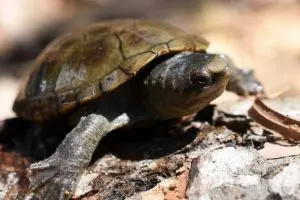
Experience Level: Intermediate
Family: Kinosternidae
Scientific Name: Kinosternon Flavescens
Adult Size: Between 3 and 5 inches
Lifespan: Between 10 and 40 years
Average price range: Between $150 and $295
Where to buy: theturtlesource.com
Found only in select regions along the Mississippi, Yellow Mud Turtles are one of the smallest species in Iowa. They mainly inhabit marshes and ponds. These little turtles like to burrow and dig, often in sandy areas.
Yellow Mud Turtles have dark, unmarked shells. Their plastrons are yellow, and they may also have some yellow coloring around their face.
Yellow Mud turtles mainly eat crustaceans, aquatic invertebrates, and mollusks. They mainly catch their prey in the water, and can consume food either in the water or on land. These turtles have a very short period of activity; from May to July.
8. Smooth Softshell Turtle
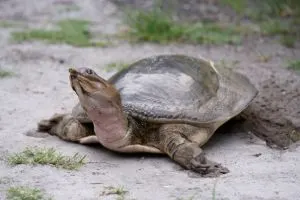
Experience Level: Intermediate to Expert
Family: Trionychidae
Scientific Name: Apalone Mutica
Adult Size: 4 ½ to 7 inches for males, 6 ½ to 14 inches for females
Lifespan: 25 years and over
Average price range: Between $40 and $60
Where to buy: theturtlesource.com
Recommended books: Softshell Turtle Owners Guide by Ben Team
Smooth Softshell turtles are found in many rivers in Iowa. They look like leathery pancakes and lack a hard carapace to protect themselves. They are usually brown or gray, with lines running from behind their eyes and snouts.
Smooth Softshells are differentiated from Spiny Softshells as the former lack ridges in their nostrils. Softshells have long, snorkel-like beaks.
They are quite calm and docile, and can even legally be caught by hand in Iowa. They usually bury themselves in sand in the shallows and sleep like this at night. They mainly eat insects, but also mollusks and crayfish.
9. Spiny Softshell Turtle
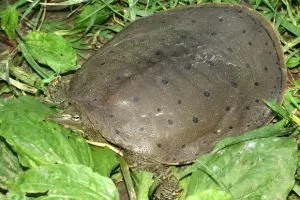
Experience Level: Intermediate to Expert
Family: Trionychidae
Scientific Name: Apalone Spinifera
Adult Size: 5 to 9 ½ inches for males, 7 to 17 inches for females
Lifespan: Between 20 and 50 years
Average price range: Between $70 and $280
Recommended books: Softshell Turtle Owners Guide by Ben Team
More common than their Smooth cousins, Spiny Softshell turtles have a pancake-like shell and sport several dark circles. To the touch, they feel like sandpaper. These turtles will scratch and bite if handled or caught. They have long, tapered beaks.
Spiny Softshells are mainly found in rivers across Iowa and require a sandy habitat for burrowing and egg laying. They sleep buried in the sand and are active during the day.
These turtles are the fastest swimmers in Iowa. They are carnivores and will feed on any crustaceans, invertebrates, and mollusks they can find. They also occasionally eat aquatic plants.
10. Northern Map Turtle
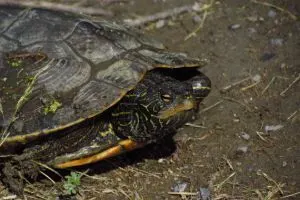
Experience Level: Beginner
Family: Emydidae
Scientific Name: Graptemys Geographica
Adult Size: Between 4 and 10 ½ inches
Lifespan: 15 to 20 years
Average price range: Between $20 and $60
Recommended books: The Map Turtle and Sawback Atlas by Peter V. Lindeman (Author), Anders G. J. Rhodin
These beautiful turtles are named for their markings, which resemble the contours of a map and are often yellow in color. Northern Map turtles have dark brown or olive green shells. Small yellow spots behind the eyes separate the Common Map turtle from other subspecies.
Common Map turtles are mainly found along the Mississippi in eastern Iowa. They are a mainly aquatic species and rarely venture far from the water. They do like to bask and are great swimmers.
Common Map turtles are mainly carnivorous, feeding on fish and aquatic invertebrates like crayfish, but also occasionally eat plants.
11. Ouachita Map Turtle
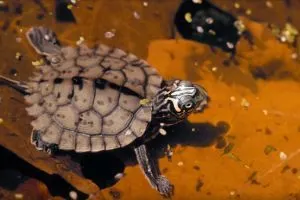
Experience Level: Beginner
Family: Emydidae
Scientific Name: Graptemys Ouachitensis
Adult Size: 3 ½ to 5 inches for males, 5 to 10 inches for females
Lifespan: Between 15 and 20 years
Average price range: Between $40 and $100
Where to buy: theturtlesource.com
Recommended books: The Map Turtle and Sawback Atlas by Peter V. Lindeman (Author), Anders G. J. Rhodin
Ouachita Map turtles can be distinguished from other Map turtles by the large yellow spots on the sides of their heads. Males have a prominent keel protruding from their dark green shells.
Ouachita Map turtles are found in the Mississippi River areas of Iowa. They are active during the day and like to bask. They are easily startled and will jump into the water.
As with many other turtles, Ouachita Map turtles are omnivores. They don’t eat as much protein as other species in the wild but will need more in captivity. They mainly eat mollusks, aquatic larvae, and plants.
12. False Map Turtle
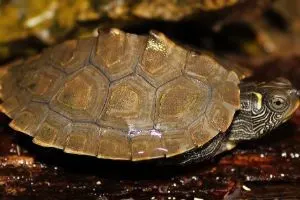
Experience Level: Beginner
Family: Emydidae
Scientific Name: Graptemys pseudogeographica
Adult Size: Between 3 ½ and 10 ½ inches
Lifespan: Between 30 and 50 years
Average price range: Between $6 and $40
Recommended books: The Map Turtle and Sawback Atlas by Peter V. Lindeman (Author), Anders G. J. Rhodin
The False Map turtle usually dwells in areas near the Mississippi and Missouri rivers that run through Iowa. They rarely travel far from the water and like to bask on outcrops over the water surface.
False Map turtles have dark shells, often brown or black, and have contour-like yellow markings. As the turtle ages, this pattern gets fainter. Most adults have a pronounced keel on their backs.
To distinguish from other Map turtles, False turtles lack colored patches and markings on their heads. This species is omnivorous and eats aquatic invertebrates, crayfish, and aquatic plants.
13. Ornate Box Turtle
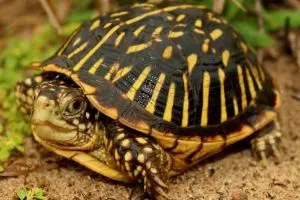
Experience Level: Intermediate to Expert
Family: Emydidae
Scientific Name: Terrapine Ornata
Adult Size: Between 4 and 5 inches
Lifespan: Up to 28 years in captivity, up to 40 years in the wild
Average price range: Between $130 and $450
Recommended books: Box Turtles (Complete Herp Care) by Tess Cook
These colorful turtles have distinctive patterning on their shells, sporting a series of yellow to orange stripes. Their bodies have light-colored speckles on their skin. They are the only completely terrestrial turtle species in Iowa.
Ornate Box turtles are mainly found in eastern Iowa, but there are a few scattered populations elsewhere in the state. Their preferred habitats of open, sandy areas are rapidly disappearing.
These turtles are active during the day and forage for food. They are mostly carnivorous and eat
Conclusion
There are 13 different turtle species native to Iowa ranging in a wide variety. The state includes mud turtles, map turtles, musk turtles, softshell turtles, snappers, pond sliders, and even wood turtles.
Other nearby states
- Turtles in Illinois
- Turtles in Minnesota
- Turtles in Missouri
- Turtles in Nebraska
- Turtles in Wisconsin
